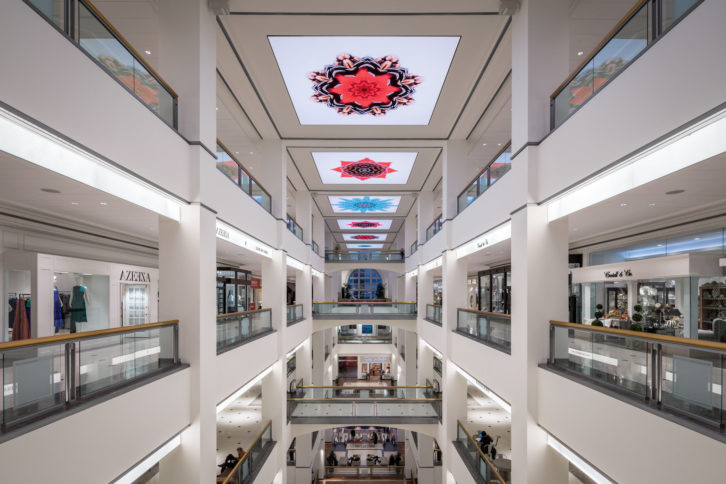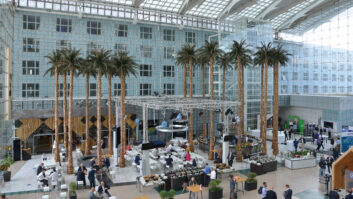
Over the 20 or so years since large LCD displays were first commercially available at an economic price their use has expanded massively.
The first advertising and information screens were introduced into the retail sector in the early 2000s. These first generation panels were little more than rolling advertising displays running video content from a local computer or media player. Then the ability was added for more personalised messaging and the screen could be split into different areas with each zone running a different set of content; turning them into more useful and informative messaging systems.
These ‘digital signage’ displays still mainly required local manual input to update and schedule content, which limited their application somewhat: shopkeepers and brand owners struggled to create and upload content that shoppers found interesting.
A major development occurred when wide bandwidth networks become more readily available. The ability to connect a large estate of screens over a wide area and have them all updated from a central point became very appealing to brand owners, retail chains and shopping centre managers. Screens in shops have flourished and are now commonplace in the retail environment, to the point that shoppers often take little interest in their content.
Brand owners and display network operators continually search for new ideas and techniques to attract the attention of the shopper; and keep them engaged while they receive messaging on products and services; all with the objective of enticing them to spend money. At the same time, and as we are all acutely aware, bricks-and-mortar shopping outlets are under threat from the internet and shop owners have to find ways to increase footfall in their retail outlets; to enable them to compete for customers from what is often a disadvantageous economic position.
New ideas
To counter these adverse effects, service and equipment providers have responded with new ideas, communication techniques and technology. One approach is to create an exciting visual experience by means of large screens and visual effects that make people want to visit. “If designed in a meaningful, relevant, and creative way, digital media can be used to create something unique in a real store that is impossible to recreate online,” explains Emily Webster, head of media architecture at ESI Design. “The best of these experiences offer a bridge between the digital and physical worlds, an idea that was used as a guiding principle for the recent renovation of Chicago’s 900 North Michigan Shops. The showcase is a 190ft-long LED art installation that spans the ceiling of the seven-level shopping centre. Visible from all floors, the installation mimics a giant skylight that creates the illusion of rustling trees or birds flocking.
That technique can be extended to act as a customer engagement centre, employing touchscreens for customers to learn about products. Webster cites the installation at Comcast’s Studio Xfinity: “The flagship space is both a store and lab, featuring 800sqft of LED screens, large-scale media installations, tablets and touchscreen surfaces. Customers play single- or multi-player games and participate in live demos. Demonstration towers show guests how to use Xfinity products. Casual seating areas and a coffee bar encourage them to stay long after their cable needs have been met.”
“Bricks and mortar retailers are becoming multi-channel experts empowering customers with the research-online-buy-offline theory”
The gap between online and offline stores is another area being addressed. Jeff Hastings, CEO at BrightSign believes that: “Customers go online just to purchase items, but go shopping for the experience. Customers enjoy the experience of going shopping in the same way as they enjoy going to the cinema. Most people are not reclusive. They don’t want to live life between four walls with everything brought to their door. They like to get out, to meet and interact with people including knowledgeable retail assistants. They love being able to see and handle the product before purchase. Central to recovering footfall in retail is the experience provided.
“This experience can be created simply by delivering a ‘wow’ factor or encouraging customers to interact with the technology that’s available in-store, but both online and offline branding should remain the same.” He believes that the two domains need to be combined into a single entity in order to fully attract the would-be purchaser. “The online and offline brand identity should create the same impression. In addition, the in-store experience should offer online options for purchasing items that are not physically available in-store, so as not to disappoint the visiting shopper.”
Multi-channel experts
Helen Kenniff, product marketing manager at Sedao Digital Signage agrees: “In a digital world where almost anything can be purchased through the touch of a button on a smartphone, bricks and mortar retailers are becoming multi-channel experts empowering customers with the research-online-buy-offline theory, which continues to bring traffic in-store. Store retailers are integrating digital technologies with traditional sales tools to connect to customers and meet their ever-changing demands and expectations. In short, retailers are digitising the in-store environment.”
It is not simply a matter of animating the local message to promote goods to customers, as was the case in the pre-internet, pre-Amazon, era. Physical shoppers expect more from their chosen retailer, as Trey Hicks, chief sales officer at Visix, explains. “Retailers are working to make the in-store experience just as convenient as online shopping. However, they also realise that people can shop for basic products online so the in-store experience has to offer something special to bring in customers. Digital signs are not only advertising products to inspire impulse and point-of-sale purchases but providing information on value-added services like personal shoppers, warranties, layaway options and loyalty programmes.”
Retail digital signage systems today are no longer one-way experiences. People everywhere, and especially the younger and more affluent generations, expect a far greater level of interactivity, always-connected instant satisfaction than ever before. “Millennials form the highest proportion of shoppers and have the highest level of disposable income, together with the desire to experience retail transactions,” says Eddie Bance retail consultant at Centrepoint AV. “They constantly interact with technology that responds to their wishes, desires and moods and anticipates their next moves. It’s no different in the shopping environment. Retail signage is no longer just a screen in a shop. It has to inform, engage, communicate and pre-empt shoppers’ desires.”
The process does not happen just while we are in a shop. Innovative methods to communicate with purchasers extend throughout their lives, wherever they are. As Keith Dutch, managing director – EMEA, Peerless-AV, explains: “Retailers can offer shoppers the opportunity to interact with brands anywhere, at any time of day. A constant stream of fresh content on-demand is now expected by retail customers. It’s up to the industry to deliver that experience through innovation; before they leave their homes, whilst they are in-store and after they return home again. All in a single unified experience.”
Driving engagement
In-store digital signage is clearly a large element of that experience. New techniques are appearing regularly to drive that customer engagement. One of the most noticeable is the trend toward larger, higher resolution displays as Dutch points out: “Large-format displays are also changing the retail landscape. Customers no longer have to wonder how something will look on them. Large panels allow shoppers to look at clothing on life-size models in never-before seen clarity on 4K screens. The absence of bezels makes the single large format display an even more seamless customer experience than its videowall predecessor.”
Identifying the right location is crucial in implementing effective digital signage in a retail space. It is about finding that sweet spot that will benefit the customer, and, overall, benefit the retailer. Retailers look for locations that are high in traffic and where they congregate for extended periods of time. Dutch: “Checkout lines are great spots for signage: customers are stationary and digital signage can be a distraction to reduce perceived wait time, as well as share information on sales. The areas inside and outside store entrances are ideal for large screens that attract passers-by and those entering the shop. When installed in windows, large screens allow retail stores to give up the lengthy process of changing window displays and can quickly be updated with new sales or models’ clothing and changed instantly to match prevailing current weather conditions.
“The industry has responded to these requirements by creating displays and mounting systems that suit the retail environment; with low profile, bezel-less screens, floor-to-ceiling mount and cable management systems and outdoor screens and housings that enable displays to continue working whatever the weather.”
Messaging has to communicate instantly, with very little effort from the viewer. “It’s all about the delivery and presentation of relevant content,” explains Serge Konter, product management, Navori. The shopper’s time is precious, and they will not stand for long in front of a sign to digest a complete playlist. As a shopper walks by, delivering a relevant message in the moment that informs or entertains is what will ultimately invoke a meaningful engagement.”
Once a shopper’s attention has been gained visually, interactive technology can take over to keep it. “The most productive advances in in-store technology allow the shopper to manipulate their experience, engage them and change what appears on-screen depending upon what they touch, scan or by their gender, age or mood,” says James Keen, group marketing manager for Tripleplay. “There are many technologies available including facial recognition such as AdMobilize, RFID solutions, NFC and lift-and-learn platforms that enhance signage and hold the shopper’s interest.”
Social media engagement is often a good way to draw customers in and encourage them to interact. “Interactivity, through the screen itself or via the customer’s own device, is the most effective way to drive engagement,” believes Hastings. “Beacon technology, like Bluetooth Low Energy (BLE), allows users to control digital signage playback from their mobile device so that promotions can be directly and locally targeted.”
Personalisation
Kenniff also believes in this approach: “Personalising the experience has been shown to immediately resonate with a customer and create a sense of engagement. It can be achieved by trigger features such as QR codes, physical and virtual buttons that give customers the ability to interact directly with in-store screens to play out content.”
Understanding the customer, their preferences, interaction and habits is essential in creating the original message and then holding their attention. No matter how innovative or sophisticated the system, audience measurement and analysis are crucial.
There are two elements. Firstly, it allows data-driven content to be presented so that adverts and messages to be displayed, based on real-time information. Instead of showing generic adverts, the content management system can trigger special messages and offers on screen. Hicks adds: “Artwork and text can be swapped out in a message based on keywords, and queuing information can be displayed and adjusted in real time. By reacting to buyer behaviour and preferences instead of just pushing out information, digital signs serve to engage customers in the store with more timely and relevant communications.”
Secondly, by understanding the audience through viewer monitoring and data analytics, retailers can deliver targeted content that is appropriate to the viewer far more effectively. Hicks continues: “A better understanding of shopper behaviour ultimately allows content creators to capture attention in the aisles more effectively. Retailers who look at digital signage as a shopper engagement platform versus a self-promotional tool are more likely to inspire return visits and drive customer loyalty, which is what ultimately increases brick and mortar foot traffic.”
Despite the trend to deploy ever-larger displays and greater interactivity, it is as yet unclear how effective these techniques are. Kenniff believes that: “It is too early to determine if there has been an increase in footfall as deployment of these types of solutions are still in their infancy. However, I do believe retailers using research online buy offline multichannel marketing campaigns will be the ultimate winners.”
Similarly Keen is unsure, but less optimistic: “With difficult trading conditions on the high street it makes any investment a risk and many of the technologies that could be adopted are not. Technology, unless it can prove an active ROI is not being deployed as widely as some might like.”
www.brightsign.biz
www.centrepointav.com
www.esidesign.com
www.navori.com
www.peerless-av.com
www.sedaosignage.com
www.tripleplay.tv
www.visix.xom







